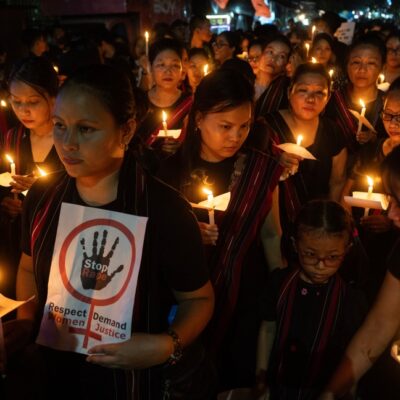In 2004, the Indonesian parliament passed a law to criminalise domestic violence. However, 20 years on, there remain substantial barriers to the law’s implementation.
On paper, the Anti-Domestic Violence Law establishes state protection for victims. Article 44 criminalises physical, sexual, psychological and economic forms of violence in the household as standalone offences. However, in practice, most cases of domestic violence in Indonesia go unreported.
The precise incidence of domestic violence is not known, due to widespread under-reporting. According to the National Statistical Bureau, 34,682 cases of domestic violence were reported to the Ministry of Women and Children’s Protection, the National Commission on Violence Against Women, and the National Forum on Service for Women Victims of Violence in 2023. Even accounting for under-reporting, this recent data underscores the urgent need for the government to take action to remedy the barriers to the law’s implementation.
Victims of domestic violence, who do report, generally do so at the community level, where the cases are informally mediated through adat (customary) justice processes. Where customary mediation fails or where the case is especially serious, domestic violence cases may progress to the state system via religious, family law or criminal law avenues.
At the community level, domestic violence is generally not viewed in a legal context but in the context of local gender and relationship norms. Community norms generally do not accurately reflect the reality of domestic violence and tend to be biased against women. For example, domestic violence is viewed as a ‘private’ problem, which deters victims from disclosing violence outside the household. Physical forms of domestic violence are also commonly justified or excused at the community level as ‘disciplinary’ or ‘educative’ in nature. Further, cases of severe physical violence tend to be hierarchically prioritised over cases that involve non-physical violence, such as psychological or economic violence, with the latter not treated as ‘proper’ domestic violence. Such misunderstandings and myths flow into the implementation of the law at every stage, including in the courts.
If a victim reports to the police, poor frontline officer understandings of domestic violence and the legal rights of victims can lead to the rejection of complaints. The lack of adequate police training creates a bottleneck in the criminal law system with very few domestic violence cases being prosecuted. The exception to police failures to protect victims or hold perpetrators accountable is arguably the Women’s and Children’s Protection Police Unit (PPA Unit). PPA Unit officers have more training and greater institutional knowledge regarding domestic violence. However, the impact of their unit is limited due to a lack of cases being referred on from frontline officers and limited institutional funding. Victims sometimes seek assistance from, or report domestic violence to, non-state institutions rather than engage with the police.
Even if a victim reports domestic violence to the police, cases are rarely prosecuted in the state courts. According to a case study of 70 domestic violence cases between 2013 and 2017, when a case is prosecuted, the state courts tend to prioritise physical violence and treat non-physical violence as less serious. In addition, the courts consistently treat domestic violence as ‘incident-based’ rather than as a pattern of coercive and controlling behaviour. For example, judges in the case study rarely considered histories of domestic violence in their decisions. Further, the case study revealed persistent inconsistencies in state court reasoning in interpreting and applying articles of the law. The lack of understanding of the realities of domestic violence indicates an urgent need for judicial education. Specialist domestic violence training must also extend to public prosecutors, police within PPA units, and frontline police officers as their understandings and actions concretely impact judicial rulings.
Similar issues arise in divorce and custody applications, which are heard by religious courts. Religious court judges tend to take a passive approach and rarely take domestic violence into account in decision-making. This is largely because judges feel that they do not have ‘jurisdiction’ to consider domestic violence. While religious court judges do not have jurisdiction to apply the criminal provisions of the Anti-Domestic Violence Law, domestic violence still falls squarely within their jurisdiction to the extent that it affects victim’s substantive divorce rights, including spousal maintenance and custody. As such, domestic violence should be considered more comprehensively by judges when deciding divorce applications.
Domestic violence training for members of the judiciary is not yet mandatory or widespread across Indonesia. The need to implement such training is pertinent, especially when considering that most violence cases in the state system are dealt with by the religious courts as divorce applications. Trainings specific to the religious courts should focus on dispelling misunderstandings and myths relating to domestic violence and encouraging the use of Supreme Court Regulation (Perma) No. 3 of 2017 on Guidelines for Judging Cases of Women in Conflict with the Law – which is a regulation that a minority of judges currently utilise to hand down non-discriminatory and gender equal judgments.
Further, the jurisdictional divide between the religious and the state courts leads to many victims falling between the cracks in the system. Reform is necessary to promote greater cooperation between the two jurisdictions. An alternative avenue would be to create a specialist Domestic Violence Court to resolve all related issues within a single case. Lastly, while the Integrated Service Centre for the Empowerment of Women and Children provide essential support to victims of domestic violence, including when filing their divorce applications or reporting to police, its capacity is limited due to a lack of institutional funding. This means that the service centre alone cannot remedy the barriers to access to justice that exist within the state system, nor is it always able to act as a safety net when religious, family and criminal law institutions fail to protect victims.
Currently, victims who report domestic violence face many hurdles, including community stigma, victim-blaming and cost and time burdens. Those who overcome these barriers to help face further barriers, particularly inadequate funding and training for institutional stakeholders and gender bias within state systems. The state is unlikely to remedy gaps in implementation of the Anti-Domestic Violence Law without consistent pressure from citizens and civil society groups to do so. The state can only be held accountable for its failure to protect victims of domestic violence and hold perpetrators accountability if the people hold the state to account.
Balawyn Jones is a Lecture, Law School, La Trobe University, Melbourne, Australia. This article contains excerpts from Balawyn Jones, Domestic Violence, Islam and Gender in Indonesia (Routledge, 2025).
Windy Triana is a Lecturer, Faculty of Sharia and Law, National Islamic University Syarif Hidayatullah (UIN).
Lilis Mulyani is a Researcher, Centre for Society and Culture, National Research and Innovation Agency (BRIN).
This article is part of a special mini-series published by Asialink’s Insights and the Asia Institute’s Melbourne Asia Review.




